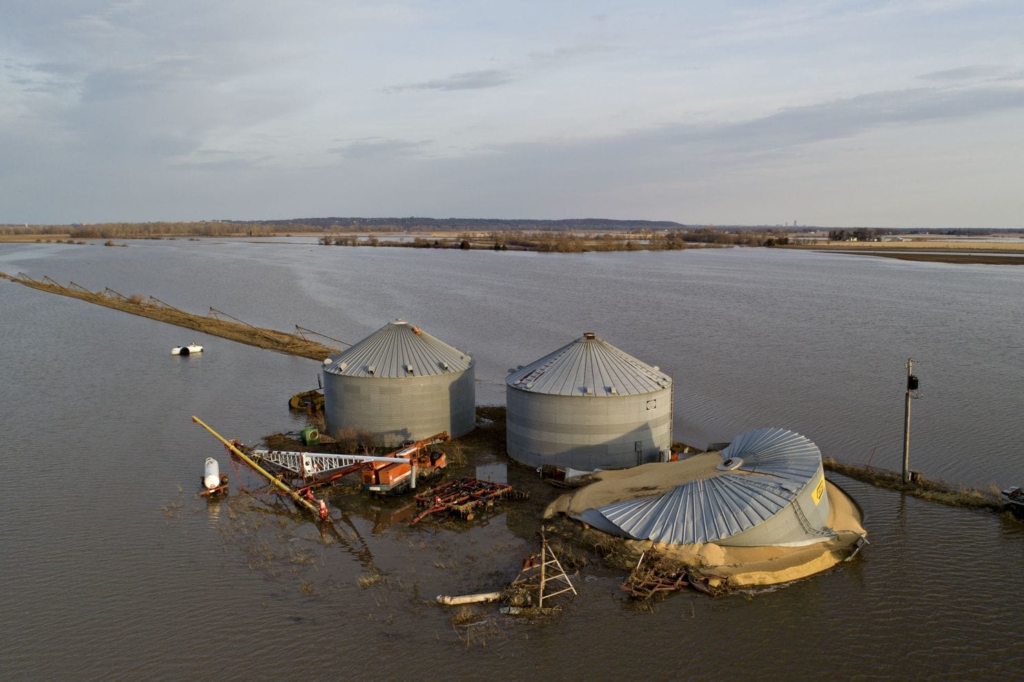U.S. farmers hit by tariffs see crops swept away by flood – Midwest flood risk to persist for months – “The most widespread destruction we have ever seen in our state’s history”

By Jim Salter
23 March 2019
ST. LOUIS (AP) – Even as floodwaters receded in hard-hit places in in the Midwest, experts warned Saturday that with plenty of snow still left to melt in northern states, the relief may only be temporary.
Rainfall and some snowmelt spurred flooding in recent weeks that’s blamed in three deaths so far, with two men in Nebraska missing for more than a week. Thousands were forced from their homes in Nebraska, Iowa and Missouri, as water broke through or poured over levees in the region. The damage is estimated at $3 billion, and that figure is expected to rise.
As temperatures start to warm, snowmelt in the Dakotas and Minnesota will escalate, sending more water down the Missouri and Mississippi rivers and their tributaries.
Lt. Col. James Startzell, deputy commander of the Corps of Engineers’ Omaha, Nebraska, district, said even warmer temperatures are possible into next week. He urged people living near rivers to be watchful.
Bill Brinton, emergency management director for hard-hit Buchanan County, Missouri, which includes St. Joseph’s 76,000 residents, said his counties and surrounding ones have already been ravaged by flooding.
“There’s a sense from the National Weather Service that we should expect it to continue to happen into May,” Brinton said. “With our levee breaches in Atchison and Holt and Buchanan counties, it’s kind of scary really.” [more]
Experts warn Midwest flood risk may persist for months

By Annie Gowen and Frances Stead Sellers
23 March 2019
SIDNEY, Iowa — His farm is still cut off by floodwaters, so Iowa soybean farmer Pat Sheldon had to view the damage from the air. On a helicopter ride over what seemed like an endless stretch of water, he came to a place he recognized as his own land — and saw that one of the grain silos had burst open, spilling yellow soybeans into the dingy, toxic water.
“It was like a punch in the gut,” Sheldon said.
“You work hard planting, taking care of these beans and harvesting them. Then, to have that happen makes you almost physically ill,” he said. “But I haven’t had time to get mad — too many responsibilities and people that need still need help.”
Although the water has yet to recede enough for a true examination, Sheldon says more than $350,000 of his corn and soybeans is in jeopardy, and he worries he may lose the farm that’s been in his family for generations.
Before the terrible “bomb cyclone” sent warm rain down on frozen ground, resulting in catastrophic flooding throughout the Midwest and displacing thousands, American farmers were already struggling after several seasons of low commodity prices and the continuing trade war with China. In towns along the overflowing Mississippi and Missouri rivers, farmers are seeing their crops — and their futures — swept away by floodwaters.
In Nebraska, Gov. Pete Ricketts (R) has called the flooding “the most widespread destruction we have ever seen in our state’s history.” Iowa has more than 100,000 acres of farmland still underwater. Officials from both states say the damage estimates are more than $1 billion and counting.
“It’s devastating for a lot of these folks, there’s no doubt about it,” said Jeff Jorgenson, a farmer and board member of the Iowa Soybean Association. “Essentially, it’s two years of negative; these farmers lost what was stored in the bins and won’t be able to plant next year’s crop. So it’s going to be really tough for a lot of people.” […]
The National Oceanic and Atmospheric Administration warned people to prepare for a prolonged disaster.
“The stage is set for record flooding now through May,” said Mary C. Erickson, deputy director of NOAA’s National Weather Service. Edward Clark, director of NOAA’s National Water Center, called it “potentially an unprecedented flood season.” […]
“We’ve had no real communication from the Corps of Engineers since this started,” said Mike Crecelius, the emergency management coordinator for Fremont County.
He estimates that there have been 14 breaches in their levees alone, causing $147 million in damage — more than $100 million from farm crops and equipment.
“It’s been one big nightmare,” he said. [more]
‘A punch in the gut’: Farmers hit by tariffs see crops swept away by flood